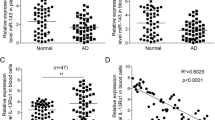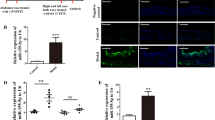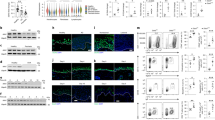Abstract
Atopic dermatitis is a chronic inflammatory skin disease characterized by the dysregulation of the epidermal barrier and the immune system. Interleukin (IL)-13, a key T helper 2 cytokine, has been shown to impair the epidermal barrier function via downregulating epidermal barrier proteins. MicroRNAs are small noncoding RNAs of approximately 22 nucleotides that act as negative regulators of gene expression at posttranscriptional levels. MicroRNA-143 is known to be a tumor suppressor in various tumors; however, its role in the regulation of allergic diseases including atopic dermatitis remains elusive. In this study, we investigated whether IL-13Rα1 was a microRNA-143 target to regulate the effects of IL-13 on epidermal barrier function. After the stimulation of IL-13 in human epidermal keratinocytes, the level of microRNA-143 was decreased. The luciferase activity of the vector containing 3′UTR of IL-13Rα1 was decreased in keratinocytes transfected with microRNA-143 mimic compared to those of the corresponding controls. The forced expression of microRNA-143 mimic blocked the IL-13-induced downregulation of filaggrin, loricrin, and involucrin in epidermal keratinocytes. Collectively, these data suggest that microRNA-143 suppresses IL-13 activity and inflammation through targeting of IL-13Rα1 in epidermal keratinocytes. MicroRNA-143 may serve as a potential preventive and therapeutic target in atopic dermatitis.




Similar content being viewed by others
References
Bieber T (2008) Atopic dermatitis. N Engl J Med 358(14):1483–1494. doi:10.1056/NEJMra074081
Leung DY (2013) New insights into atopic dermatitis: role of skin barrier and immune dysregulation. Allergol Int 62(2):151–161. doi:10.2332/allergolint.13-RAI-0564
Eichenfield LF, Tom WL, Chamlin SL, Feldman SR, Hanifin JM, Simpson EL, Berger TG, Bergman JN, Cohen DE, Cooper KD, Cordoro KM, Davis DM, Krol A, Margolis DJ, Paller AS, Schwarzenberger K, Silverman RA, Williams HC, Elmets CA, Block J, Harrod CG, Smith Begolka W, Sidbury R (2014) Guidelines of care for the management of atopic dermatitis: section 1. Diagnosis and assessment of atopic dermatitis. J Am Acad Dermatol 70(2):338–351. doi:10.1016/j.jaad.2013.10.010
Shaw TE, Currie GP, Koudelka CW, Simpson EL (2011) Eczema prevalence in the United States: data from the 2003 National Survey of Children’s Health. J Investig Dermatol 131(1):67–73. doi:10.1038/jid.2010.251
Hamid Q, Naseer T, Minshall EM, Song YL, Boguniewicz M, Leung DY (1996) In vivo expression of IL-12 and IL-13 in atopic dermatitis. J Allergy Clin Immunol 98(1):225–231
Jeong CW, Ahn KS, Rho NK, Park YD, Lee DY, Lee JH, Lee ES, Yang JM (2003) Differential in vivo cytokine mRNA expression in lesional skin of intrinsic vs. extrinsic atopic dermatitis patients using semiquantitative RT-PCR. Clin Exp Allergy: J Br Soc Allergy Clin Immunol 33(12):1717–1724
Nomura I, Goleva E, Howell MD, Hamid QA, Ong PY, Hall CF, Darst MA, Gao B, Boguniewicz M, Travers JB, Leung DY (2003) Cytokine milieu of atopic dermatitis, as compared to psoriasis, skin prevents induction of innate immune response genes. J Immunol 171(6):3262–3269
Neis MM, Peters B, Dreuw A, Wenzel J, Bieber T, Mauch C, Krieg T, Stanzel S, Heinrich PC, Merk HF, Bosio A, Baron JM, Hermanns HM (2006) Enhanced expression levels of IL-31 correlate with IL-4 and IL-13 in atopic and allergic contact dermatitis. J Allergy Clin Immunol 118(4):930–937. doi:10.1016/j.jaci.2006.07.015
Howell MD, Kim BE, Gao P, Grant AV, Boguniewicz M, Debenedetto A, Schneider L, Beck LA, Barnes KC, Leung DY (2007) Cytokine modulation of atopic dermatitis filaggrin skin expression. J Allergy Clin Immunol 120(1):150–155. doi:10.1016/j.jaci.2007.04.031
Kim BE, Leung DY, Boguniewicz M, Howell MD (2008) Loricrin and involucrin expression is down-regulated by Th2 cytokines through STAT-6. Clin Immunol 126(3):332–337. doi:10.1016/j.clim.2007.11.006
Pellerin L, Henry J, Hsu CY, Balica S, Jean-Decoster C, Mechin MC, Hansmann B, Rodriguez E, Weindinger S, Schmitt AM, Serre G, Paul C, Simon M (2013) Defects of filaggrin-like proteins in both lesional and nonlesional atopic skin. J Allergy Clin Immunol 131(4):1094–1102. doi:10.1016/j.jaci.2012.12.1566
Brauweiler AM, Goleva E, Leung DY (2014) Th2 cytokines increase Staphylococcus aureus alpha toxin-induced keratinocyte death through the signal transducer and activator of transcription 6 (STAT6). J Investig Dermatol 134(8):2114–2121. doi:10.1038/jid.2014.43
Makeyev EV, Maniatis T (2008) Multilevel regulation of gene expression by microRNAs. Science 319(5871):1789–1790. doi:10.1126/science.1152326
Schneider MR (2012) MicroRNAs as novel players in skin development, homeostasis and disease. Br J Dermatol 166(1):22–28. doi:10.1111/j.1365-2133.2011.10568.x
Lu TX, Rothenberg ME (2013) Diagnostic, functional, and therapeutic roles of microRNA in allergic diseases. J Allergy Clin Immunol 132(1):3–13. doi:10.1016/j.jaci.2013.04.039
Kent OA, McCall MN, Cornish TC, Halushka MK (2014) Lessons from miR-143/145: the importance of cell-type localization of miRNAs. Nucleic Acids Res 42(12):7528–7538. doi:10.1093/nar/gku461
Yu S, Zhang R, Liu G, Yan Z, Hu H, Yu S, Zhang J (2011) Microarray analysis of differentially expressed microRNAs in allergic rhinitis. Am J Rhinol Allergy 25(6):e242–e246. doi:10.2500/ajra.2011.25.3682
Teng Y, Zhang R, Liu C, Zhou L, Wang H, Zhuang W, Huang Y, Hong Z (2015) miR-143 inhibits interleukin-13-induced inflammatory cytokine and mucus production in nasal epithelial cells from allergic rhinitis patients by targeting IL13Ralpha1. Biochem Biophys Res Commun 457(1):58–64. doi:10.1016/j.bbrc.2014.12.058
Sonkoly E, Janson P, Majuri ML, Savinko T, Fyhrquist N, Eidsmo L, Xu N, Meisgen F, Wei T, Bradley M, Stenvang J, Kauppinen S, Alenius H, Lauerma A, Homey B, Winqvist O, Stahle M, Pivarcsi A (2010) MiR-155 is overexpressed in patients with atopic dermatitis and modulates T-cell proliferative responses by targeting cytotoxic T lymphocyte-associated antigen 4. J Allergy Clin Immunol 126(3):581–589. doi:10.1016/j.jaci.2010.05.045
Yu S, Zhang R, Zhu C, Cheng J, Wang H, Wu J (2013) MicroRNA-143 downregulates interleukin-13 receptor alpha1 in human mast cells. Int J Mol Sci 14(8):16958–16969. doi:10.3390/ijms140816958
Sonkoly E, Wei T, Janson PC, Saaf A, Lundeberg L, Tengvall-Linder M, Norstedt G, Alenius H, Homey B, Scheynius A, Stahle M, Pivarcsi A (2007) MicroRNAs: novel regulators involved in the pathogenesis of psoriasis? PLoS One 2(7):e610. doi:10.1371/journal.pone.0000610
Rebane A, Runnel T, Aab A, Maslovskaja J, Ruckert B, Zimmermann M, Plaas M, Karner J, Treis A, Pihlap M, Haljasorg U, Hermann H, Nagy N, Kemeny L, Erm T, Kingo K, Li M, Boldin MP, Akdis CA (2014) MicroRNA-146a alleviates chronic skin inflammation in atopic dermatitis through suppression of innate immune responses in keratinocytes. J Allergy Clin Immunol 134(4):836–847. doi:10.1016/j.jaci.2014.05.022
Lin L, Hou J, Ma F, Wang P, Liu X, Li N, Wang J, Wang Q, Cao X (2013) Type I IFN inhibits innate IL-10 production in macrophages through histone deacetylase 11 by downregulating microRNA-145. J Immunol 191(7):3896–3904. doi:10.4049/jimmunol.1203450
Akao Y, Nakagawa Y, Iio A, Naoe T (2009) Role of microRNA-143 in Fas-mediated apoptosis in human T-cell leukemia Jurkat cells. Leuk Res 33(11):1530–1538. doi:10.1016/j.leukres.2009.04.019
Zhao W, Zhao SP, Zhao YH (2015) MicroRNA-143/-145 in cardiovascular diseases. BioMed Res Int 2015:531740. doi:10.1155/2015/531740
Kim ST, Lee KM, Park HJ, Jin SE, Ahn WS, Kim CK (2009) Topical delivery of interleukin-13 antisense oligonucleotides with cationic elastic liposome for the treatment of atopic dermatitis. J Gene Med 11(1):26–37. doi:10.1002/jgm.1268
Ingram JL, Kraft M (2012) IL-13 in asthma and allergic disease: asthma phenotypes and targeted therapies. J Allergy Clin Immunol 130(4):829–842. doi:10.1016/j.jaci.2012.06.034
Tsuchisaka A, Furumura M, Hashimoto T (2014) Cytokine regulation during epidermal differentiation and barrier formation. J Investig Dermatol 134(5):1194–1196. doi:10.1038/jid.2014.15
Omori-Miyake M, Yamashita M, Tsunemi Y, Kawashima M, Yagi J (2014) In vitro assessment of IL-4- or IL-13-mediated changes in the structural components of keratinocytes in mice and humans. J Investig Dermatol 134(5):1342–1350. doi:10.1038/jid.2013.503
Hatano Y, Adachi Y, Elias PM, Crumrine D, Sakai T, Kurahashi R, Katagiri K, Fujiwara S (2013) The Th2 cytokine, interleukin-4, abrogates the cohesion of normal stratum corneum in mice: implications for pathogenesis of atopic dermatitis. Exp Dermatol 22(1):30–35. doi:10.1111/exd.12047
Candi E, Schmidt R, Melino G (2005) The cornified envelope: a model of cell death in the skin. Nat Rev Mol Cell Biol 6(4):328–340. doi:10.1038/nrm1619
Palmer CN, Irvine AD, Terron-Kwiatkowski A, Zhao Y, Liao H, Lee SP, Goudie DR, Sandilands A, Campbell LE, Smith FJ, O’Regan GM, Watson RM, Cecil JE, Bale SJ, Compton JG, DiGiovanna JJ, Fleckman P, Lewis-Jones S, Arseculeratne G, Sergeant A, Munro CS, El Houate B, McElreavey K, Halkjaer LB, Bisgaard H, Mukhopadhyay S, McLean WH (2006) Common loss-of-function variants of the epidermal barrier protein filaggrin are a major predisposing factor for atopic dermatitis. Nat Genet 38(4):441–446. doi:10.1038/ng1767
Steinert PM, Marekov LN (1997) Direct evidence that involucrin is a major early isopeptide cross-linked component of the keratinocyte cornified cell envelope. J Biol Chem 272(3):2021–2030
Blanchard C, Stucke EM, Burwinkel K, Caldwell JM, Collins MH, Ahrens A, Buckmeier BK, Jameson SC, Greenberg A, Kaul A, Franciosi JP, Kushner JP, Martin LJ, Putnam PE, Abonia JP, Wells SI, Rothenberg ME (2010) Coordinate interaction between IL-13 and epithelial differentiation cluster genes in eosinophilic esophagitis. J Immunol 184(7):4033–4041. doi:10.4049/jimmunol.0903069
Acknowledgments
This study was funded by Young scientific research fund of Peking Union Medical College Hospital (No. PUMCH-2013-063) and Chinese Medical Association—L’OREAL CHINA SKIN GRANT 2016 (No. S2016131413).
Author contribution
The manuscript has been read and approved by all the authors. The criteria for authorship have been met. All authors have participated sufficiently in the work and its writing to take public responsibility for the whole content.
Funding
This study was funded by Young scientific research fund of Peking Union Medical College Hospital (No. PUMCH-2013-063) and Chinese Medical Association—L’OREAL CHINA SKIN GRANT 2016 (No. S2016131413).
Author information
Authors and Affiliations
Corresponding author
Ethics declarations
Conflict of Interest
Yue-Ping Zeng has received research grants from L’OREAL.
Rights and permissions
About this article
Cite this article
Zeng, YP., Nguyen, G.H. & Jin, HZ. MicroRNA-143 inhibits IL-13-induced dysregulation of the epidermal barrier-related proteins in skin keratinocytes via targeting to IL-13Rα1. Mol Cell Biochem 416, 63–70 (2016). https://doi.org/10.1007/s11010-016-2696-z
Received:
Accepted:
Published:
Issue Date:
DOI: https://doi.org/10.1007/s11010-016-2696-z




